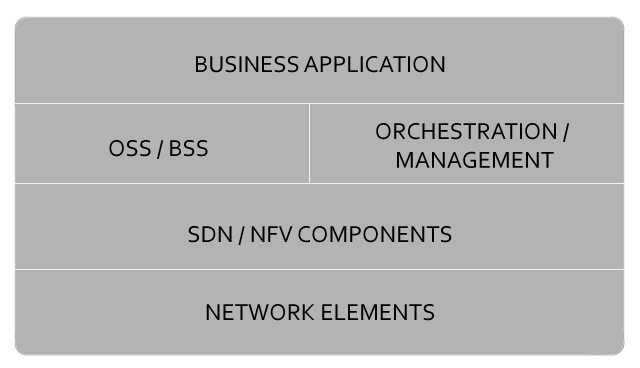Networks
As Data Networks Become Virtual, Enterprise Integration Must Become a Reality

Last week, as I was walking down the hallway, I came across two gentlemen painting a hallway door. They paused and kindly let me through. While I waited, I caught a glimpse of a door with a sign that read, in big bold red letters, “pre-action sprinkler control”. What exactly is a “pre-action”?, I thought, as I started walking again. Is it an action that occurs before the actual action? Wouldn’t that be an action itself? I was a bit puzzled.
In fire systems, I later learned, “pre-action” is the act of validating the existence of a fire, and filling up the pipes with water, in preparation for the sprinklers to open. The system prepares itself for instantaneous flow of water (or a fire-suppressing agent).
The Role of Network Management Systems
Isn’t that what business and operations support system (BSS/OSS) applications try to accomplish: prepare the network for the instantaneous flow of data? A customer order functions as the “pre-action” to automatically and seamlessly trigger network provisioning. That’s true but, unlike pipes in a fire system, networks are subject to constant change. Businesses, for instance, want dynamic topologies and bandwidth-on-demand to support their changing needs. At the same time, they expect high reliability, high availability and low cost.
One of the main problems enterprise software systems experience is “pre-action” signals (messages) that do not propagate deep enough into the software stack to reach the network elements and enable the flow of data. In the current BSS/OSS environment, data paths lack integration capabilities, such as standard API endpoints; and data structures are incomplete or lack minimal structure. Overcoming these gaps requires labor-intensive activities such as custom, point-to-point integrations that are brittle, difficult to modify and, above all, expensive to maintain. This is the equivalent of manually filling the pipes with water, and then turning on each sprinkler head individually within a fire system.
The lack of an enterprise integration strategy also has a negative impact on the bottom line: long lead times, high integration costs, low customer satisfaction, lost business opportunities and revenue.
Poor enterprise integration can also slow the pace of innovation. It is also difficult and costly for current and future technology partners to successfully contribute new solutions to the operator’s ecosystem.
The Advent of Network Softwarization
As data networks are undergoing a fundamental shift towards virtualization and “softwarization”, enterprise integration strategies must become a reality in order for operators to remain competitive. Hardware commoditization, cloud and virtualization technologies are increasing the pace of innovation and the delivery of better products and services. At the same time, our daily life demands a higher degree of connectivity. For example, current content consumption trends demand multi-media integration. Beyond linking social and online presence with TV content, media integration requires multiple media streams, applications and network resources to allow access to content whenever and wherever the consumer is. This is the approach Netflix has embraced to go from zero to 29.8 million streaming subscribers in the US in the span of only 7 years.
As the software stack pushes down into the network, network functions become software applications. We must recognize software-defined networks (SDN) and network function virtualization (NFV) for what they are: layers of the enterprise software architecture. Several architectures have been proposed to tackle network “softwarization.” Most rely on the layers and enterprise integration boundaries depicted in Figure 1.

Figure 1. Typical Enterprise Architecture
Operators will need to go beyond SDN and NFV alone to make a business innovative and competitive. Now more than ever, the OSS/BSS layers will need to play a significant role in seamlessly incorporating new vendor-neutral network technologies into the business.
For networks to become truly agile, SDN and NFV will need to be able to seamlessly “plug” into an end-to-end enterprise integration strategy. This demands a different approach to BSS/OSS. Services will need to be provisioned, managed and monitored the way a virtualized IT function manages virtual resources, applications lifecycle, commodity hardware and data centers. Companies with large networks, such as Google, have realized the importance of the management plane (another name for OSS/BSS) and have decided to open their models and protocols in the hope of getting help solving the provisioning and orchestration problems.
At the same time, global, business-to-business networks require intra-organizational as well as inter-organizational enterprise integration patterns, APIs and data structures.
Tackling the Network Virtualization Challenge
Several organizations and trade groups have recognized the impact of network virtualization on the enterprise. They have traditionally attacked the problem from different points of view, target different audiences and provide different artifacts.
TM Forum, a consortium that helps network operators prepare for the digital economy, looks at the entire enterprise and provides abstract data models (SID, eTOM, etc) and aggregate business entities. In comparison, the Metro Ethernet Forum (MEF), with its focus on Carrier Ethernet services, remains closer to the network constructs and models. MEF has done some groundbreaking work developing data models for carrier ethernet service definition, and to a lesser extent, management. For an architectural point of view, TM Forum has taken a top down approach while MEF has take a bottom up approach.
Although both TM Forum and MEF have recently innovated beyond their traditional spaces with initiatives such as ZOOM and Third Network, cable operators need a comprehensive enterprise integration strategy that merges these approaches to enable network-driven services and business models. Such strategy demands a way to capture a unified and comprehensive view of the enterprise.
A Cable Industry Solution: CL-IM
CableLabs, its member operators and suppliers have come together to develop CableLabs Information Model (CL-IM), a cable-friendly information model that distills, reconciles and extends the work being done by TM Forum and MEF. One of the outcomes of this joint effort is a set of implementable artifacts: a reusable library of data models and application programming interfaces (APIs). The approach has proven successful and several use cases have already been implemented using these artifacts.
CableLabs members now have at their disposal actionable enterprise integration artifacts that can enable seamless data paths, from the backend to the network. Just like in a fire system, such data paths will prepare the network for the instantaneous, on-demand flow of data in response to customer demands. With instantaneous response comes agility. Quick response and agility can be the catalysts that accelerate the development of innovative applications built over virtual networks. They can also enable platforms where members, suppliers and business partners can come together to leverage positive network effects and implement high value business opportunities.
By Adolfo Perez-Duran —



